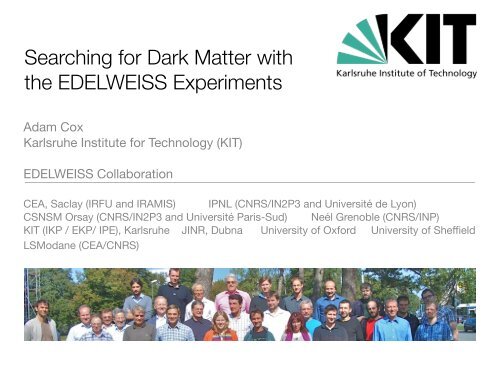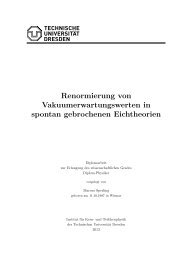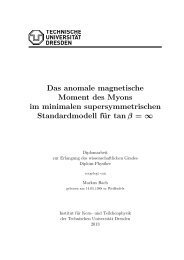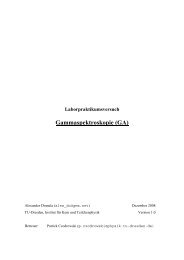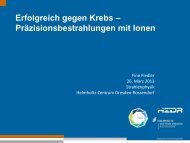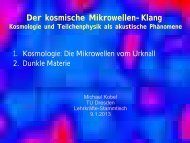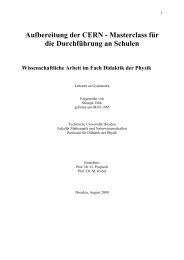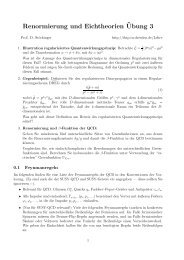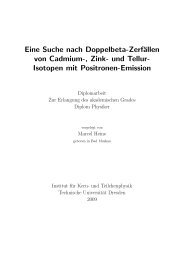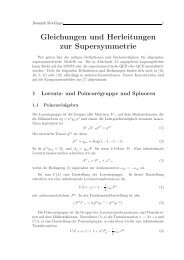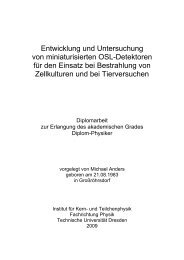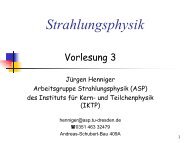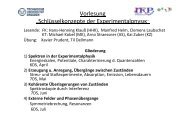Searching for Dark Matter with the EDELWEISS Experiments
Searching for Dark Matter with the EDELWEISS Experiments
Searching for Dark Matter with the EDELWEISS Experiments
You also want an ePaper? Increase the reach of your titles
YUMPU automatically turns print PDFs into web optimized ePapers that Google loves.
<strong>Searching</strong> <strong>for</strong> <strong>Dark</strong> <strong>Matter</strong> <strong>with</strong><br />
<strong>the</strong> <strong>EDELWEISS</strong> <strong>Experiments</strong><br />
Adam Cox<br />
Karlsruhe Institute <strong>for</strong> Technology (KIT)<br />
<strong>EDELWEISS</strong> Collaboration<br />
CEA, Saclay (IRFU and IRAMIS) IPNL (CNRS/IN2P3 and Université de Lyon)<br />
CSNSM Orsay (CNRS/IN2P3 and Université Paris-Sud) Neél Grenoble (CNRS/INP)<br />
KIT (IKP / EKP/ IPE), Karlsruhe JINR, Dubna University of Ox<strong>for</strong>d University of Sheffield<br />
LSModane (CEA/CNRS)
• Briefly: Evidence <strong>for</strong> <strong>Dark</strong> <strong>Matter</strong><br />
• Direct WIMP <strong>Dark</strong> <strong>Matter</strong> Detection Introduction<br />
• Edelweiss II<br />
• Experimental setup and results<br />
• Current Worldwide Direct Detection Status<br />
• Edelweiss III<br />
TU Dresden. G. Adam Cox 6 December 2012<br />
2
Astrophysical Evidence <strong>for</strong> <strong>Dark</strong> <strong>Matter</strong><br />
• Galactic Rotation Curves -<br />
probably most compelling<br />
TU Dresden. G. Adam Cox 6 December 2012<br />
3
Astrophysical Evidence <strong>for</strong> <strong>Dark</strong> <strong>Matter</strong><br />
• Gravitational Lensing implies more matter than visibly accounted<br />
TU Dresden. G. Adam Cox 6 December 2012<br />
Bullet cluster<br />
4
Astrophysical Evidence <strong>for</strong> <strong>Dark</strong> <strong>Matter</strong><br />
• Cosmic Microwave Background model (measured by WMAP)<br />
TU Dresden. G. Adam Cox 6 December 2012<br />
5
What are we looking <strong>for</strong> in Edelweiss?<br />
• Gravitationally interacting<br />
• Weakly interacting <strong>with</strong> baryons, no electromagnetic interaction (no charge)<br />
• Long lived (~age of <strong>the</strong> Universe decay time)<br />
TU Dresden. G. Adam Cox 6 December 2012<br />
6
What are we looking <strong>for</strong> in Edelweiss?<br />
• Gravitationally interacting<br />
• Weakly interacting <strong>with</strong> baryons, no electromagnetic interaction (no charge)<br />
• Long lived (~age of <strong>the</strong> Universe decay time)<br />
• Neutrinos, Axions, KK particles (axinos, gravitinos, sneutrinos, ...)<br />
• cMSSM one possible Lightest Supersymmetric Particle (LSP): Neutralino is<br />
<strong>the</strong> most-popular WIMP candidate. O<strong>the</strong>r LSPs exist depending upon <strong>the</strong><br />
model and parameters.<br />
• cMSSM models give Neutralino M ~ 100 GeV and σA ~ 10 -9 pb (coherent<br />
elastic scattering) -- need large exposures to detect (~400 kgd in EDW 2)<br />
TU Dresden. G. Adam Cox 6 December 2012<br />
6
How to detect a WIMP<br />
• Weakly Interacting Massive Particle - searching <strong>for</strong> elastic/inelastic scattering of nuclei<br />
WIMP light<br />
heavy<br />
nuclei<br />
TU Dresden. G. Adam Cox 6 December 2012<br />
target<br />
material<br />
e -<br />
h +<br />
Na, I, Ar, Xe, Ge, Si, Ca, W, O...<br />
charge<br />
heat<br />
7
Direct Detection <strong>Experiments</strong> by Mechanism<br />
<strong>EDELWEISS</strong><br />
CDMS<br />
SuperCDMS<br />
EURECA<br />
CoGeNT<br />
TU Dresden. G. Adam Cox 6 December 2012<br />
<strong>EDELWEISS</strong><br />
heat<br />
charge light<br />
XENON<br />
WARP, ArDM,<br />
LUX, ZEPLIN<br />
CRESST<br />
EURECA<br />
XMASS<br />
DAMA/LIBRA<br />
8
Ge Nuclei Recoil Signal Characteristics<br />
dR<br />
dE r<br />
= " 0 # 0<br />
2<br />
2m $m r<br />
F 2 (q) dv f νesc<br />
%<br />
& 1(v)<br />
v<br />
v min<br />
J.D. Lewin and P.F. Smith, Astropart. Phys. 6 (1996) 87<br />
(counts/keV/kg/yr/pb)<br />
-1<br />
<br />
dR<br />
dE<br />
!<br />
3<br />
10<br />
2 10<br />
10<br />
-1<br />
10<br />
-2 10<br />
0 2 4 6 8 10 12 14 16 18 20<br />
TU Dresden. G. Adam Cox 6 December 2012 Energy (keVnr)<br />
1<br />
f 1 = k "<br />
2<br />
v<br />
v0 3 e#v 2 / v 0 2<br />
WIMP Mass: 50 GeV<br />
Maxwellian<br />
WIMP Mass: 10 GeV<br />
WIMP Mass: 15 GeV<br />
WIMP Mass: 50 GeV<br />
vesc<br />
9
Ge Nuclei Recoil Signal Characteristics<br />
Include velocity of Earth<br />
dR/dE ~ 7%<br />
TU Dresden. G. Adam Cox 6 December 2012<br />
mχ = 30 GeV<br />
10
Ge Nuclei Recoil Signal Characteristics<br />
Include velocity of Earth<br />
dR/dE ~ 7%<br />
TU Dresden. G. Adam Cox 6 December 2012<br />
mχ = 8 GeV<br />
11
Edelweiss Signal Readout<br />
<strong>EDELWEISS</strong><br />
TU Dresden. G. Adam Cox 6 December 2012<br />
heat<br />
charge light<br />
12
Edelweiss Signal Readout<br />
<strong>EDELWEISS</strong><br />
TU Dresden. G. Adam Cox 6 December 2012<br />
heat<br />
charge light<br />
6 electrodes (e - , holes)<br />
NTD <strong>the</strong>rmal sensor<br />
NTD<br />
12
<strong>EDELWEISS</strong> in a Nutshell<br />
• Array of cryogenically<br />
cooled Germanium<br />
crystals<br />
(10 in II, 40 in III)<br />
• Elastic Scattering of<br />
Ge by WIMPs<br />
• Rare event search:<br />
underground and<br />
shielded experiment<br />
TU Dresden. G. Adam Cox 6 December 2012<br />
13
<strong>EDELWEISS</strong> in a Nutshell<br />
• Array of cryogenically<br />
cooled Germanium<br />
crystals<br />
(10 in II, 40 in III)<br />
• Elastic Scattering of<br />
Ge by WIMPs<br />
• Rare event search:<br />
underground and<br />
shielded experiment<br />
TU Dresden. G. Adam Cox 6 December 2012<br />
Ge recoil produces heat +<br />
ionization<br />
Erecoil<br />
13
<strong>EDELWEISS</strong> in a Nutshell<br />
• Array of cryogenically<br />
cooled Germanium<br />
crystals<br />
(10 in II, 40 in III)<br />
• Elastic Scattering of<br />
Ge by WIMPs<br />
• Rare event search:<br />
underground and<br />
shielded experiment<br />
TU Dresden. G. Adam Cox 6 December 2012<br />
4800 mwe<br />
Ge recoil produces heat +<br />
ionization<br />
Polyethylene<br />
shield<br />
Muon Veto<br />
Pb shield<br />
cryostat<br />
Erecoil<br />
Neutron<br />
counter<br />
13
TU Dresden. G. Adam Cox 6 December 2012 14
TU Dresden. G. Adam Cox 6 December 2012 14
Detection Principle<br />
Exploit Ionization Yield of Nuclear Recoils<br />
β, γ<br />
TU Dresden. G. Adam Cox 6 December 2012<br />
ELECTRON<br />
RECOIL<br />
15
Detection Principle<br />
Exploit Ionization Yield of Nuclear Recoils<br />
β, γ<br />
TU Dresden. G. Adam Cox 6 December 2012<br />
ELECTRON<br />
RECOIL<br />
WIMP, NEUTRON<br />
NUCLEAR<br />
RECOIL<br />
~1/3 as many<br />
electron-hole pairs<br />
compared to<br />
electron recoil<br />
15
Detection Principle<br />
Exploit Ionization Yield of Nuclear Recoils<br />
β, γ<br />
• Quenching or Ionization Yield - Q ~ 0.2 - 0.3<br />
• Distinguish nuclear recoil (NR) from electron recoil<br />
• Neutrons and WIMPs - nuclear recoil<br />
TU Dresden. G. Adam Cox 6 December 2012<br />
ELECTRON<br />
RECOIL<br />
WIMP, NEUTRON<br />
NUCLEAR<br />
RECOIL<br />
~1/3 as many<br />
electron-hole pairs<br />
compared to<br />
electron recoil<br />
15
Detection Principle<br />
TU Dresden. G. Adam Cox 6 December 2012<br />
from AmBe calibration data<br />
16
Detection Principle<br />
TU Dresden. G. Adam Cox 6 December 2012<br />
6 electrodes (e - , holes)<br />
NTD <strong>the</strong>rmal sensor<br />
from AmBe calibration data<br />
NTD<br />
16
Detection Principle<br />
Erecoil ~ Eheat (after N-L corrections)<br />
Ionization Yield<br />
Eionization / Erecoil<br />
TU Dresden. G. Adam Cox 6 December 2012<br />
6 electrodes (e - , holes)<br />
NTD <strong>the</strong>rmal sensor<br />
from AmBe calibration data<br />
NTD<br />
electron recoil<br />
(gammas)<br />
Ge nucleus recoil<br />
~1/3 as many<br />
electron-hole pairs<br />
16
Why Inter-Digitized Electrodes?<br />
Planar Electrode<br />
design in EDW 1<br />
TU Dresden. G. Adam Cox 6 December 2012<br />
17
Why Inter-Digitized Electrodes?<br />
Planar Electrode<br />
design in EDW 1<br />
TU Dresden. G. Adam Cox 6 December 2012<br />
Results from EDW 1<br />
17
Why Inter-Digitized Electrodes?<br />
Planar Electrode<br />
design in EDW 1<br />
TU Dresden. G. Adam Cox 6 December 2012<br />
Results from EDW 1<br />
Events near <strong>the</strong><br />
surface suffer from<br />
charge collection loss<br />
17
Readout Channels<br />
charge carriers<br />
follow E-field lines<br />
+4.0 -1.0<br />
e-<br />
h<br />
-4.0 +1.0<br />
lattice excitations<br />
= <strong>the</strong>rmal phonons<br />
TU Dresden. G. Adam Cox 6 December 2012 18<br />
NTD
CENPA MM. G. Adam Cox 17 September 2012 19
Event Location<br />
For each trigger, we have readout from all channels and use this to reconstruct <strong>the</strong> event.<br />
top view Ge crystal<br />
TU Dresden. G. Adam Cox 6 December 2012<br />
electrodes (e - , holes)<br />
NTD <strong>the</strong>rmal sensor<br />
20
Event Location<br />
For each trigger, we have readout from all channels and use this to reconstruct <strong>the</strong> event.<br />
top view Ge crystal<br />
Event Types:<br />
TU Dresden. G. Adam Cox 6 December 2012<br />
electrodes (e - , holes)<br />
NTD <strong>the</strong>rmal sensor<br />
20
Event Location<br />
For each trigger, we have readout from all channels and use this to reconstruct <strong>the</strong> event.<br />
top view Ge crystal<br />
Event Types:<br />
Fiducial: A,C<br />
TU Dresden. G. Adam Cox 6 December 2012<br />
electrodes (e - , holes)<br />
NTD <strong>the</strong>rmal sensor<br />
20
Event Location<br />
For each trigger, we have readout from all channels and use this to reconstruct <strong>the</strong> event.<br />
top view Ge crystal<br />
Event Types:<br />
Fiducial: A,C<br />
Surface: A,B<br />
TU Dresden. G. Adam Cox 6 December 2012<br />
electrodes (e - , holes)<br />
NTD <strong>the</strong>rmal sensor<br />
20
Event Location<br />
For each trigger, we have readout from all channels and use this to reconstruct <strong>the</strong> event.<br />
top view Ge crystal<br />
Event Types:<br />
Fiducial: A,C<br />
Surface: A,B<br />
TU Dresden. G. Adam Cox 6 December 2012<br />
electrodes (e - , holes)<br />
NTD <strong>the</strong>rmal sensor<br />
Surface Low Field: A,C +B<br />
20
Event Location<br />
For each trigger, we have readout from all channels and use this to reconstruct <strong>the</strong> event.<br />
top view Ge crystal<br />
Event Types:<br />
Fiducial: A,C<br />
Surface: A,B<br />
TU Dresden. G. Adam Cox 6 December 2012<br />
electrodes (e - , holes)<br />
NTD <strong>the</strong>rmal sensor<br />
Surface Low Field: A,C +B<br />
Pure Guard: G, H<br />
20
Event Location<br />
For each trigger, we have readout from all channels and use this to reconstruct <strong>the</strong> event.<br />
top view Ge crystal<br />
Event Types:<br />
Fiducial: A,C<br />
Surface: A,B<br />
TU Dresden. G. Adam Cox 6 December 2012<br />
electrodes (e - , holes)<br />
NTD <strong>the</strong>rmal sensor<br />
n<br />
Surface Low Field: A,C +B<br />
Pure Guard: G, H<br />
O<strong>the</strong>r (anything but noise... usually multi-regional)<br />
20
ID Detectors: Surface Event Rejection<br />
Measurement<br />
• 210 Pb source to test <strong>for</strong><br />
surface event rejection<br />
• Reject all events <strong>with</strong> signals<br />
on veto or guard electrodes<br />
• 6 x 10 -5 rejection factor<br />
• ID design state-of-<strong>the</strong>-art. To<br />
be used now in SuperCDMS<br />
(iZIP detectors)<br />
TU Dresden. G. Adam Cox 6 December 2012<br />
21
Putting it all toge<strong>the</strong>r<br />
• Measure Heat and Ionization production from interaction<br />
• Quenching Factor distinguishes Nuclear Recoils from Electrons<br />
• Interleaved Electrode Design rejects surface betas<br />
• Next: Signal Processing Tools (plus calibration)<br />
• Next: Search <strong>for</strong> Fiducial Volume events in large data set<br />
TU Dresden. G. Adam Cox 6 December 2012<br />
22
Signal Processing Tools Needed<br />
• Bandpass filters / Wiener Optimal Filtering / Match Filters / Pulse<br />
Fitting / Cross-Talk Removal<br />
garde ID3AB baseline remove<br />
40<br />
20<br />
0<br />
-20<br />
-40<br />
0 1000 2000 3000 4000<br />
(Edw 2 pulses look different from Edw 3)<br />
TU Dresden. G. Adam Cox 6 December 2012<br />
garde ID3AB baseline remove + pattern remove<br />
20<br />
0<br />
-20<br />
0 1000 2000 3000 4000<br />
[10 μs]<br />
23
Signal Processing Tools Needed<br />
• Bandpass filters / Wiener Optimal Filtering / Match Filters / Pulse<br />
Fitting / Cross-Talk Removal<br />
~ 50 keV<br />
TU Dresden. G. Adam Cox 6 December 2012<br />
[1 second]<br />
Slow Heat pulse<br />
Not simple exponential<br />
Non-linearity<br />
24
Event Reconstruction: Erecoil and Q<br />
from Ionization and Heat Signals<br />
For each event, can<br />
express EI and EH as<br />
TU Dresden. G. Adam Cox 6 December 2012<br />
EI = QER<br />
EH = ER<br />
1+QV/✏<br />
1+V/✏<br />
25
Event Reconstruction: Erecoil and Q<br />
from Ionization and Heat Signals<br />
For each event, can<br />
express EI and EH as<br />
rearranging<br />
TU Dresden. G. Adam Cox 6 December 2012<br />
EI = QER<br />
EH = ER<br />
Q = EI<br />
ER =<br />
ER<br />
✓<br />
1+ V<br />
1+QV/✏<br />
1+V/✏<br />
✏<br />
◆<br />
EH<br />
V<br />
✏ EI<br />
25
Event Reconstruction: Erecoil and Q<br />
from Ionization and Heat Signals<br />
For each event, can<br />
express EI and EH as<br />
rearranging<br />
TU Dresden. G. Adam Cox 6 December 2012<br />
EI = QER<br />
EH = ER<br />
Q = EI<br />
ER =<br />
ER<br />
✓<br />
1+ V<br />
1+QV/✏<br />
1+V/✏<br />
✏<br />
◆<br />
EH<br />
Q γ ≡ 1 Q n = 0.165 ER 0.185<br />
V<br />
✏ EI<br />
25
Gamma Band and Nuclear Recoil Band<br />
neutrons from<br />
AmBe source<br />
TU Dresden. G. Adam Cox 6 December 2012<br />
133 Ba<br />
3+-1 10 -5 rejection of<br />
gammas in NR band<br />
26
Data Quality Cuts<br />
• Spin <strong>the</strong> Data and only accept events:<br />
• during stable cryogenic conditions<br />
• during stable low-noise environment<br />
• good Chi^2 cuts on pulse shapes<br />
• fiducial volume only events (of course)<br />
• reject time-correlated events <strong>with</strong> o<strong>the</strong>r detectors (neutrons) and <strong>the</strong><br />
Muon Veto system (muons)<br />
TU Dresden. G. Adam Cox 6 December 2012<br />
27
“High” Energy Edelweiss 2 Results<br />
• July - Nov 2008 and April 2009<br />
- May 2010<br />
• 427 kg * days<br />
• 384 kg * days in 90% NR band<br />
• 5 events in NR band > 20 keV<br />
TU Dresden. G. Adam Cox 6 December 2012<br />
Phys. Lett. B 702 (2011) 329<br />
28
Direct Detection Status early 2012<br />
TU Dresden. G. Adam Cox 6 December 2012<br />
DAMA/LIBRA EPJ C56 (2008)<br />
CoGeNT PRL 106 (2011)<br />
CRESST II 2 sigma arXiv: 1109.0702<br />
CRESST II 1 sigma arXiv: 1109.0702<br />
CDMS Low E, PRL 106 (2011)<br />
CDMS + EDW, Phys Rev D 84 (2011)<br />
ZEPLIN III, arXiv: 1110.4769<br />
XENON100 PRL 107 (2011)<br />
XENON10 Low E, PRL 107 (2011)<br />
CMSSM Trotta et al, (2008)<br />
CMSSM <strong>with</strong> LHC and XENON 100<br />
Buchmueller et al, arXiv: 1110.3568<br />
29
Direct Detection Status early 2012<br />
TU Dresden. G. Adam Cox 6 December 2012<br />
DAMA/LIBRA EPJ C56 (2008)<br />
CoGeNT PRL 106 (2011)<br />
CRESST II 2 sigma arXiv: 1109.0702<br />
CRESST II 1 sigma arXiv: 1109.0702<br />
CDMS Low E, PRL 106 (2011)<br />
CDMS + EDW, Phys Rev D 84 (2011)<br />
ZEPLIN III, arXiv: 1110.4769<br />
XENON100 PRL 107 (2011)<br />
XENON10 Low E, PRL 107 (2011)<br />
CMSSM Trotta et al, (2008)<br />
CMSSM <strong>with</strong> LHC and XENON 100<br />
Buchmueller et al, arXiv: 1110.3568<br />
29
Direct Detection Status early 2012<br />
TU Dresden. G. Adam Cox 6 December 2012<br />
DAMA/LIBRA EPJ C56 (2008)<br />
CoGeNT PRL 106 (2011)<br />
CRESST II 2 sigma arXiv: 1109.0702<br />
CRESST II 1 sigma arXiv: 1109.0702<br />
CDMS Low E, PRL 106 (2011)<br />
CDMS + EDW, Phys Rev D 84 (2011)<br />
ZEPLIN III, arXiv: 1110.4769<br />
XENON100 PRL 107 (2011)<br />
XENON10 Low E, PRL 107 (2011)<br />
CMSSM Trotta et al, (2008)<br />
CMSSM <strong>with</strong> LHC and XENON 100<br />
Buchmueller et al, arXiv: 1110.3568<br />
29
Direct Detection <strong>Experiments</strong><br />
• DAMA / LIBRA (light only): WIMPs?<br />
• XENON and ZEPLIN no WIMPs<br />
• CRESST WIMPs?<br />
• CoGeNT (charge only) WIMPs?<br />
• CDMS and <strong>EDELWEISS</strong> no WIMPs<br />
TU Dresden. G. Adam Cox 6 December 2012<br />
30
Direct Detection <strong>Experiments</strong><br />
• DAMA / LIBRA (light only): WIMPs?<br />
• XENON and ZEPLIN no WIMPs<br />
• CRESST WIMPs?<br />
• CoGeNT (charge only) WIMPs?<br />
• CDMS and <strong>EDELWEISS</strong> no WIMPs<br />
TU Dresden. G. Adam Cox 6 December 2012<br />
30
Direct Detection <strong>Experiments</strong><br />
• DAMA / LIBRA (light only): WIMPs?<br />
• XENON and ZEPLIN no WIMPs<br />
• CRESST WIMPs?<br />
• CoGeNT (charge only) WIMPs?<br />
• CDMS and <strong>EDELWEISS</strong> no WIMPs<br />
TU Dresden. G. Adam Cox 6 December 2012<br />
30
Direct Detection <strong>Experiments</strong><br />
• DAMA / LIBRA (light only): WIMPs?<br />
• XENON and ZEPLIN no WIMPs<br />
• CRESST WIMPs?<br />
• CoGeNT (charge only) WIMPs?<br />
• CDMS and <strong>EDELWEISS</strong> no WIMPs<br />
Energy spectrum<br />
TU Dresden. G. Adam Cox 6 December 2012<br />
Light yield distribution<br />
30
Direct Detection <strong>Experiments</strong><br />
• DAMA / LIBRA (light only): WIMPs?<br />
• XENON and ZEPLIN no WIMPs<br />
• CRESST WIMPs?<br />
• CoGeNT (charge only) WIMPs?<br />
• CDMS and <strong>EDELWEISS</strong> no WIMPs<br />
counts/30days<br />
TU Dresden. G. Adam Cox 6 December 2012<br />
30
Direct Detection <strong>Experiments</strong><br />
• DAMA / LIBRA (light only): WIMPs?<br />
• XENON and ZEPLIN no WIMPs<br />
• CRESST WIMPs?<br />
• CoGeNT (charge only) WIMPs?<br />
• CDMS and <strong>EDELWEISS</strong> no WIMPs<br />
TU Dresden. G. Adam Cox 6 December 2012<br />
30
Direct Detection <strong>Experiments</strong><br />
• DAMA / LIBRA (light only): WIMPs?<br />
• XENON and ZEPLIN no WIMPs<br />
• CRESST WIMPs?<br />
• CoGeNT (charge only) WIMPs?<br />
• CDMS and <strong>EDELWEISS</strong> no WIMPs<br />
TU Dresden. G. Adam Cox 6 December 2012<br />
30
Low Energy Analysis<br />
• Subset of detectors <strong>with</strong> exceptionally good resolutions and low backgrounds<br />
• Different parameterization of event observables (independent axis)<br />
• 5 - 20 keV analysis (independent data set)<br />
• Construct 2D (EI,ER) WIMP signal PDF, including detector / analysis efficiencies<br />
• Count number of events observed inside a 90% WIMP PDF region <strong>for</strong> a given<br />
mass and cross-section (no background subtraction or background model)<br />
• Find largest cross-section that corresponds to 90% CL Poisson limit given <strong>the</strong><br />
observed number of events in <strong>the</strong> WIMP PDF region<br />
TU Dresden. G. Adam Cox 6 December 2012<br />
31
Low Energy Analysis<br />
Convert ONLY heat signal<br />
to nuclear recoil energy<br />
Independent: EI , ER<br />
TU Dresden. G. Adam Cox 6 December 2012<br />
32
Low Energy Data Set<br />
• 4 / 10 detectors used<br />
• 113 kg days<br />
• neutrons from calibration in gray<br />
• blue lines 95% gamma rejection<br />
• blue points - events that fall into<br />
<strong>the</strong> 90%CL region <strong>for</strong> a particular<br />
WIMP model used to test <strong>for</strong> upper<br />
limit cross section<br />
TU Dresden. G. Adam Cox 6 December 2012<br />
33
Setting Cross-Section Limits<br />
ID3, 10 GeV<br />
TU Dresden. G. Adam Cox 6 December 2012<br />
• For each WIMP mass<br />
• convolve all measured<br />
efficiencies <strong>for</strong> trigger, threshold,<br />
resolution, cuts, etc...<br />
• construct WIMP 2D PDF<br />
• determine 90%CL WIMP<br />
“Box” (red line in figure)<br />
• count # of events in box and set<br />
limit assuming Poisson statistics<br />
34
Setting Low Mass Limits<br />
ID2, 30 GeV<br />
ID6, 25 GeV<br />
3 candidates<br />
TU Dresden. G. Adam Cox 6 December 2012<br />
ID404, 20 GeV<br />
3 candidates<br />
ID6, 8 GeV<br />
No candidate<br />
35
Low Mass WIMP Cross Section Limits<br />
TU Dresden. G. Adam Cox 6 December 2012<br />
36
Maximum Likelihood Analysis <strong>for</strong> Low Mass<br />
Events / 30 days<br />
L = Y r⇢ (E,t) +<br />
16<br />
14<br />
12<br />
10<br />
8<br />
6<br />
4<br />
2<br />
0<br />
(1 r)⇢ (E,t)<br />
Events / 30 days<br />
16<br />
14<br />
12<br />
10<br />
0.2 0.4<br />
0<br />
0.6 0.2 0.8 0.4 1 0.6 0.8<br />
0<br />
0 1<br />
2 3 4<br />
0<br />
5 0 6 1 7 2 8 39 410 5 6 7 8 9 10<br />
Time [years] Time [years]<br />
Energy [keV] Energy [keV]<br />
TU Dresden. G. Adam Cox 6 December 2012<br />
8<br />
6<br />
4<br />
2<br />
Events / 0.67 keV<br />
16<br />
14<br />
12<br />
10<br />
8<br />
6<br />
4<br />
2<br />
Events / 0.67 keV<br />
mχ = 8 GeV<br />
σ ~7e-40 cm -2<br />
• Heat Energy / Time<br />
• Time-dependent model and<br />
efficiencies<br />
• ID3<br />
16<br />
14<br />
12<br />
10<br />
8<br />
6<br />
4<br />
2<br />
37
ection [cm 2 ] (normalised Cross−section to nucleon) [cm 2 ] (normalise<br />
40<br />
42<br />
44<br />
46<br />
48<br />
10<br />
Maximum Likelihood Analysis <strong>for</strong> Low Mass<br />
−42<br />
http://dmtools.brown.edu/<br />
Spin Independent σA [cm -2 ]<br />
120712090201<br />
10 −44<br />
10 −40<br />
10-40 10 −46<br />
10 −42<br />
10-42 XENON1T (proj.)<br />
Preliminary<br />
10 −44<br />
10<br />
120712090201 −48<br />
TU Dresden. G. Adam Cox 6 December 2012<br />
Preliminary<br />
XENON1T (proj.)<br />
EURECA (proj.)<br />
10 50<br />
10 100 1000<br />
| | | | | | | |<br />
• Preliminary<br />
EDW-II PLB 702,5 (2011) 329<br />
DAMA/LIBRA http://dmtools.brown.edu/<br />
EPJ C56 (2008)<br />
CoGeNT PRL 106 (2011)<br />
• In principle, CRESST should II 2σ arXiv:1109.0702 obtain better<br />
limits CRESST by using II entire 1σ arXiv:1109.0702 parameter<br />
space (should be relatively trivial<br />
CDMS Science 327, 1619 (2010)<br />
to add ionization energy)<br />
+ Low E, PRL 106 (2011)<br />
• Need XENON100 to have an arXiv:1207.5988 accurate<br />
gamma background model<br />
EURECA (proj.)<br />
+ PRD 86, 051701(R) (2012)<br />
EDW-III proj. 24kg(fid) 6 months<br />
EDW & CDMS comb. PRD 84 (2011)<br />
XENON100 PRL 107 (2011)<br />
Buchmüller et al, 2011<br />
Bertone et al, 2011<br />
• Improved analysis to come<br />
beginning of 2013<br />
WIMP Mass [GeV/c 2 10 100 1000<br />
WIMP Mass [GeV/c<br />
]<br />
2 10 50<br />
WIMP Mass [GeV/c] 2 ]<br />
38<br />
| | | |
<strong>EDELWEISS</strong> III<br />
TU Dresden. G. Adam Cox 6 December 2012<br />
EDW-3 projected 3000 kg.d<br />
24kg fid. mass x 125days<br />
39
Increased Exposure: More detectors and Fiducial Volume<br />
• Inter-Digitized --> Fully Inter-Digitized<br />
• Fiducial Volume: 40% --> 75%<br />
• 400g --> 800g<br />
• 40 New Detectors<br />
• 6 months = 3000 kg days<br />
• ~1 detector fabricated per week<br />
• Expect full delivery summer 2013<br />
TU Dresden. G. Adam Cox 6 December 2012<br />
FID800<br />
>600g<br />
40
TU Dresden. G. Adam Cox 6 December 2012 41
Gammas<br />
• FIDs appear to show better<br />
gamma rejection (400k events)<br />
• Cleaner Tools:<br />
• Cabling<br />
• Holders<br />
TU Dresden. G. Adam Cox 6 December 2012<br />
42
Gammas<br />
• FIDs appear to show better<br />
gamma rejection (400k events)<br />
• Cleaner Tools:<br />
• Cabling<br />
• Holders<br />
TU Dresden. G. Adam Cox 6 December 2012<br />
42
Energy Resolution<br />
• New Front-End Electronics<br />
• No Feedback Resister on FET<br />
• Relays recharge electrodes<br />
• 500 eV FWHM (maybe 300 eV)<br />
TU Dresden. G. Adam Cox 6 December 2012<br />
EDW 2<br />
EDW 3<br />
43
Neutron Shielding<br />
• Redesigned cryostat<br />
• Block neutrons from Pb shield<br />
• Add inner PE shielding (in orange)<br />
TU Dresden. G. Adam Cox 6 December 2012<br />
Pb<br />
Pb Pb<br />
44
New Data Management / Routing System<br />
• Replace old, poorly functioning, unsupported hardware <strong>with</strong> new electronics<br />
from IPE group at KIT (also builds similar system <strong>for</strong> Auger, KATRIN)<br />
TU Dresden. G. Adam Cox 6 December 2012<br />
Single Crate<br />
Eliminates Many Hardware Issues<br />
Event Building<br />
Muon Veto + O<strong>the</strong>r Subsystems<br />
Very Scalable (Next-Gen ready)<br />
Eventually will implement triggering<br />
on <strong>the</strong> crate<br />
45
Conclusions<br />
• Edelweiss II<br />
• Excellent background rejection <strong>with</strong> ID design<br />
• Setting limits at low-mass comparable to XENON/CDMS and in contradiction <strong>with</strong><br />
CoGeNT / DAMA / CRESST<br />
• Maximum Likelihood (and o<strong>the</strong>r statistical methods) analysis to come<br />
• Edelweiss III<br />
• 32 kg of detector mass (24 kg fiducial) starting mid-2013<br />
• Less background, better energy resolution<br />
• Strong limit (or discovery) <strong>for</strong> 2013/2014<br />
TU Dresden. G. Adam Cox 6 December 2012<br />
46


